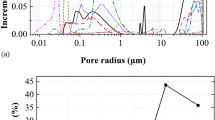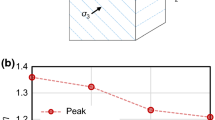Abstract
Thermoelastic behavior of different marble types was analyzed using computational modeling and experimental measurements. Eight marble samples with different composition, grain size, grain boundary geometry, and texture were investigated. Calcitic and dolomitic marbles were considered. The average grain size varies from 75 μm to 1.75 mm; grain boundary geometry differs from nearly equigranular straight grain boundaries to inequigranular-interlobate grain boundaries. Four typical marble texture types were observed by EBSD measurements: weak texture; strong texture; girdle texture and high-temperature texture. These crystallographic orientations were used in conjunction with microstructure-based finite element analysis to compute the thermoelastic responses of marble upon heating. Microstructural response maps highlight regions and conditions in the marble fabric that are susceptible to degradation phenomena. This behavior was compared to the measured thermal expansion behavior, which shows increasing residual strains upon repetitive heating–cooling cycles. The thermal expansion behavior as a function of temperature changes can be classified into four categories: (a) isotropic thermal expansion with small or no residual strain; (b) anisotropic thermal expansion with small or no residual strain; (c) isotropic thermal expansion with a residual strain; and (d) anisotropic thermal expansion with residual strain. Thermal expansion coefficients were calculated for both simulated and experimental data and also modeled from the texture using the MTEX software. Fabric parameters control the amount and directional dependence of the thermal expansion. Marbles with strong texture show higher directional dependence of the thermal expansion coefficients and have smaller microstructural values of the maximum principal stress and strain energy density, the main precursors of microcracking throughout the marble fabric. In contrast, marbles with weak texture show isotropic thermal expansion behavior, have a higher propensity to microcracking, and exhibit higher values of maximum principal stress and strain energy density. Good agreement between the experimental and computational results is observed, demonstrating that microstructure-based finite-element simulations are an excellent tool for elucidating influences of rock fabric on thermoelastic behavior.













Similar content being viewed by others
References
Bass JD (1995) Elasticity of minerals, glasses, and melts. In: Ahrens TJ (ed) Handbook of physical constants. American Geophysical Union, Washington, pp 45–63
Battaglia S, Franzini M, Mango F (1993) High sensitivity apparatus for measuring linear thermal expansion: preliminary results on the response of marbles. II Nuovo Cimento 16:453–461
Bunge HJ (1982) Texture analysis in material sciences. Butterworth, London
Bunge HJ (1985) Representation of preferred orientations. In: Preferred orientation in deformed metals and rocks: an introduction to modern texture analysis. Academic Press, New York, pp 73–108
Carter WC, Langer SA, Fuller ER (1998) The OOF manual: version 1.0. National Institute of Standards and Technology (NIST), NISTIR No.6256
Chawla N, Patel BV, Koopman M, Chawla KK, Saha R, Patterson BR, Fuller ER, Langer SA (2003) Microstructure-based simulation of thermomechanical behavior of composite materials by object-oriented finite element analysis. Mater Charact 49:395–407
Grüneisen E (1926) Zustand des festen Körpers. In: Geiger H, Scheel K (eds) Handbuch der Physik, Bd. 10: Thermische Eigenschaften der Stoffe. Springer, Berlin
Halfpenny A (2010) Some important practical issues for the collection and manipulation of electron backscatter diffraction (EBSD) data from geological samples. In: Forster, MA, John D. Fitz Gerald (eds) The Science of Microstructure—Part I, J Virtual Explorer, Electronic edn, ISSN 1441-8142, vol 35, p 3, doi:10.3809/jvirtex.2011.00272
Hielscher R, Schaeben H (2008) A novel pole figure inversion method: specification of the MTEX algorithm. J Appl Crystallogr 41:1024–1037. doi:10.1107/S0021889808030112
Kessler DW (1919) Physical and chemical tests on the commercial marbles of the United States. Technologic Papers Bureau of Standards, No. 123, Government Printing Office, Washington
Kleber W (1959) Einfiihrung in die Kristallographie. VEB Verlag Technik, Berlin
Koch A, Siegesmund S (2004) The combined effect of moisture and temperature on the anomalous behaviour of marbles. Environ Geol 46:350–363
Langer SA, Fuller ER, Carter WC (2001) OOF: an image-based finite element analysis of material microstructures. Comput Sci Eng 3:15–23. (OOF is freely available at http://www.ctcms.nist.gov/oof/)
Leiss B, Molli G (2003) High-temperature texture in naturally deformed Carrara marble from Alpi Apuane, Italy. J Struct Geol 25:649–658
Leiss B, Ullemeyer K (1999) Texture characterisation of carbonate rocks and some implication for the modeling of physical anisotropies, derived from idealized texture types. Z Deut Geol Ges 150:259–274
Luque A, Ruiz-Agudo E, Cultrone G, Sebastián E, Siegesmund S (2011) Direct observation of microcrack development in marble caused by thermal weathering. Environ Earth Sci 62(7):1375–1386
Mainprice D, Hielscher R, Schaeben H (2011) Calculating anisotropic physical properties from texture data using the MTEX open source package. In: Prior DJ, Rutter EH, Tatham DJ (eds) Deformation mechanisms, rheology and tectonics: microstructures, mechanics and anisotropy. Geological Society, London, Special Publications 360, pp 175–192
Rabinowitzt M, Carr J (2012) The New York public library statuary-marble deterioration and conservation. In: 12th International congress on deterioration and conservation of stone, New York (in print)
Reeder R, Markgraf SA (1986) High temperature crystal chemistry of dolomite. Am Mineral 71:795–804
Ritter H (1992) Die Marmorplatten sind falsch dimensioniert. Stein H. 1/1992:18–19
Ruedrich J (2003) Gefügekontrollierte Verwitterung natürlicher und konservierter Marmore. Dissertation, Universität Göttingen, 158 S
Ruedrich J, Weiss T, Siegesmund S (2002) Thermal behaviour of consolidated marbles. In: Siegesmund S, Weiss T, Vollbrecht A (eds) Natural stone, weathering phenomena, conservation strategies and case studies. Geological Society Special Publication No. 205, The Geological Society of London, London, pp 255–271
Saylor DM, Fuller ER, Weiss T (2007) Thermal-elastic response of marble polycrystals: influence of grain orientation configuration. Int J Mat Res (formerly Z. Metallkd.) 98(12):1256–1263
Shushakova V, Fuller ER, Siegesmund S (2011) Influence of shape fabric and crystal texture on marble degradation phenomena: simulations. Environ Earth Sci 63:1587–1601
Shushakova V, Fuller ER, Siegesmund S (2012) Microcracking in calcite and dolomite marble: microstructural influences and effects on properties. Environ Earth Sci. doi:10.1007/s12665-012-1995-2
Siegesmund S, Weiss T, Vollbrecht A, Ullemeyer K (1999) Marble as a natural building show: rock fabrics, physical and mechanical properties. Z Dtsch Geol Ges 150:237–257
Siegesmund S, Ullemeyer K, Weiss T, Tschegg EK (2000) Physical weathering of marbles caused by anisotropic thermal expansion. Int J Earth Sci 89:170–182
Siegesmund S, Ruedrich J, Koch A (2008) Marble bowing: comparative studies of different public building facades. In: Siegesmund S, Snethlage R, Ruedrich J (eds) Monumental future: climate change, air pollution, stone decay and conservation. Environ Geol, vol 56, pp 473–494
Trewitt TJ, Tuchmann J (1988) Amoco may replace marble on Chicago headquarters. ENR March: 11–12
Tschegg E, Widhalm C, Eppensteiner W (1999) Ursachen mangelnder Formbestaetigkeit von Marmorplatten. Zeitschrift der Deutschen Geologischen Gesellschaft 150(2):283–297
Wanner T, Fuller ER, Saylor DM (2010) Homology metrics for microstructure response fields in polycrystals. Acta Mater 58:102–110
Weiss T, Siegesmund S, Fuller ER (2002) Thermal stresses and microcracking in calcite and dolomite marbles via finite element modelling. In: Siegesmund S, Weiss T, Vollbrecht A (eds) Natural stone, weathering phenomena, conservation strategies and case studies. Geological Society Special Publication No. 205, The Geological Society of London, London, pp 89–102
Weiss T, Siegesmund S, Fuller ER (2003) Thermal degradation of marble: indications from finite-element modelling. Build Environ 38(9–10):1251–1260
Weiss T, Saylor DM, Fuller ER, Siegesmund S (2004) Prediction of the degradation behaviour of calcareous rocks via finite-element modelling. In: 10th International congress on deterioration and conservation of stone, Stockholm, pp 163–170
Widhalm C, Tschegg E, Eppensteiner (1996) Anisotropic thermal expansion causes deformation of marble cladding. J Perform Constr Facil 10:5–10
Zeisig A, Siegesmund S, Weiss T (2002) Thermal expansion and its control on the durability of marbles. In: Siegesmund S, Weiss T, Vollbrecht A (eds) Natural stone, weathering phenomena, conservation strategies and case studies. Geological Society Special Publication No. 205, The Geological Society of London, London, pp 65–80
Acknowledgments
The authors gratefully acknowledge Grelk and Jan Anders Brundin for Fig. 1. Financial support for E. R. Fuller, Jr. at Universität Göttingen was provided by the Deutsche Forschungsgemeinschaft grant: SI 438/39–1, and is gratefully acknowledged. Victoria Shushakova gratefully acknowledges a long-term DAAD fellowship grant.
Author information
Authors and Affiliations
Corresponding author
Rights and permissions
About this article
Cite this article
Shushakova, V., Fuller, E.R., Heidelbach, F. et al. Marble decay induced by thermal strains: simulations and experiments. Environ Earth Sci 69, 1281–1297 (2013). https://doi.org/10.1007/s12665-013-2406-z
Received:
Accepted:
Published:
Issue Date:
DOI: https://doi.org/10.1007/s12665-013-2406-z




